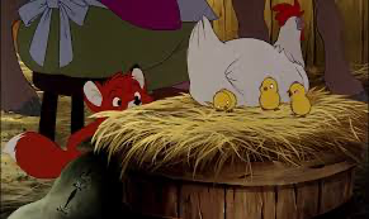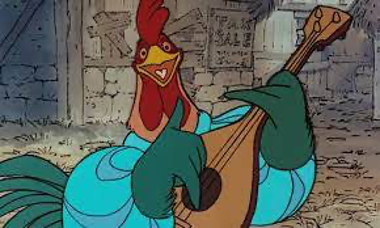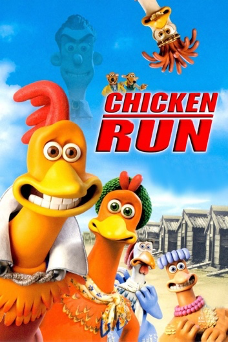Whilst researching how animals have been depicted by Walt Disney Animation Studios (WADAS)[1], I found that chickens were featured in nineteen WDAS films (34%) (Stanton, 2019). This makes chickens the most commonly depicted species of bird in WDAS films. This fact is perhaps surprising given that chickens are undoubtedly not WDAS’s most notable or memorable bird characters. With the exceptions of Chicken Little, Lady Kluck, and Hei Hei, I struggled to even name any of WDAS’s other bird characters from my immediate memory. This is perhaps because WDAS’s more notable birds have been their sidekick/henchmen characters. Such characters are usually based upon wild or exotic bird species, such as the evil raven Diablo from Sleeping Beauty (1959), the wise owl Archimedes from The Sword and Stone (1963), and the screechy macaw Iago in Aladdin (1992). It is these bird characters that have individual personalities and are anthropomorphised, traits that make them more memorable.

Despite being very common characters, chickens are usually (with the exception of just four films) quite unremarkable in WDAS films. In most films, chickens are in the background with little individuality or anthropomorphism. For example, in The Fox and the Hound (1981), the chickens are less developed than the other animal characters in the film. The fox (Tod), Copper (the dog), and the owl (Big Mama) can speak and express many human-like facial emotions. In contrast, none of the chickens speak or are heavily-anthropomorphised. Another example is Home on the Range (2004), which is set on a farm populated with traditional farm animals. In this film, the chickens are under-developed as characters when compared to the film’s other farm animals. For instance, the chickens have far less screen time than the cows, horse, and goat. Additionally, the chickens do little to prevent their farm from being taken over, whereas many of the other farm animals are instrumental in protecting it. Thus, in WDAS films, chickens are usually less developed, less anthropomorphised, and less central to the story than the other animal characters (even other bird characters) in their diegetic world. I also found that this was the case with the films of other animation companies. For example, in Blue Sky Studios’ bird-focussed film Rio (2011), the chicken characters do not speak, whereas the parrots, toucans, and so forth do.
Another observation I had was towards how the chickens in WDAS films were behaving and being treated. Even though chickens are often less individualized and under-developed in animation (when compared to other species of animal), they are rarely portrayed laying eggs or being processed into chicken meat.
This is notable as this is what chickens are mostly bred for in reality. Additionally, I have yet to find a depiction of a de-beaked chicken in animation, even though most chickens in the world today are or will be de-beaked (BHWT, 2019). Thus, most chickens in animation are free-range and not objectified as food, even though they often exist in a farm context. This is perhaps because animation generally tends to attenuate animal harm towards all species (Stanton, 2020).
Chickens feature in nineteen WDAS films, and in just four of these films they are given a starring or supporting role. Firstly, there is also Panchito Pistolles, a heavily-anthropomorphized talking rooster from The Three Caballeros (1945). Secondly, in Robin Hood (1973), the all-animal cast includes two heavily-anthropomorphized chicken characters: Alan-A-Dale (the rooster narrator) and Lady Kluck, (Maid Marion’s lady-in-waiting).

Thirdly, there is, of course, Chicken Little (and his father Buck Cluck) from Chicken Little (2005). Fourthly, there is the hapless rooster Hei Hei from Moana (2016). There are a few points to be made about how these four films portrayed chickens as individualized characters. Firstly, these four films do remove chickens from the farm context that chickens usually exist in. This suggests that WDAS has occasionally attempted to push the boundaries when it comes to their chicken characters. Yet, with the notable exception of Lady Kluck (who is actually distinctive for several reasons – she is one of WDAS’s only female sidekicks, human, animal, or otherwise, for example), all of these individualized chickens are roosters. Basically, they are male chickens, not female chickens. So, whilst WDAS’s occasional pushing of boundaries with chicken characters may be somewhat progressive in one way, it is perhaps oppressive in another. In fact, the majority of WDAS’s notable bird characters generally (such as Zazu from The Lion King [1994], Flit from Pocahontas [1995], and the birds mentioned in the first paragraph) have been male. Of course, this observation is perhaps true of storytelling generally. The promotion of male characters over female characters is not really specific to animation or even to Disney or WDAS. Yet with chickens, the focus upon males is a bit more illogical than usual given that most chickens alive today are female (Anonymous, 2020).

human disguises.
Other animation companies have also occasionally created standalone individualized chicken characters, and, like WDAS, it is again roosters that have been developed, rather than hens. It is also the case that the lives of these animated roosters do not reflect the harsh reality that most chickens today experience. For example, Loony Tunes’ (1930-1969) often featured Foghorn Leghorn, an unusually large comedic rooster known for his mischievous pranks. Animaniacs (1993-1998) featured the peculiar rooster Chicken Boo, an anthropomorphized rooster that adopted various human disguises.

And of course, perhaps the most notable example of animated chickens comes from Aardman Animations’ stop-motion film Chicken Run (2000), which centers around a group of chickens attempting to escape from a chicken factory before they are processed into chicken pies. Whilst Chicken Run does feature a far-healthier mix of male and female chickens, it should be highlighted that the hero chicken is male, and it is he (Rocky) who is instrumental in saving the female chickens from their gruesome fate. Thus, female chickens are once again not given the starring role that they perhaps deserve. It also must be acknowledged that Chicken Run does recognise the common harms that chickens face in reality. However, very few of the chickens in this film are actually harmed, and, unsurprisingly, the film ends with the chickens managing to safely escape their gruesome fate (Cole and Stewart, 2014).
So, what can these observations tell us about chickens in animation? Or animation generally? Well, I think there are two points to be concluded and reflected upon here. Firstly, the characterization of chickens in animation prioritizes males over females. Whilst this point is perhaps true of storytelling generally, having more roosters than hens is particularly illogical given that most chickens alive today are female. Given WDAS’s recent attempts to improve their portrayals of females, I would suggest that they should extend this progress to all females, including female animals, such as hens. My second conclusion is that WDAS’s portrayal of chickens once again highlights that animal harm is often attenuated in animation. In terms of numbers, there are more chickens killed annually than any other land animal (Deckers, 2016: 54). Yet, this morbid fact is absent from WDAS’s films and animation generally, even though these films frequently feature chicken characters. One of the only films that have challenged this narrative is Aardman Animations’ Chicken Run. Yet whilst Chicken Run is far more reflective of reality, its optimistic ending reinforces the idea that chickens are rarely harmed. This is problematic because recent research suggests that 71% of people believe that free-range hens are happy and content (Norwood and Lusk, 2011: 247). This belief is likely aided by portrayals of chickens in cultural depictions, such as those found in animated films. These findings were not quite what I had expected when I initially started researching birds. In fact, it didn’t even occur to me that birds, especially chickens, would be a male-dominated category of animals in WDAS films. However, upon reflection, this is may simply be because we are so used to seeing more male characters than females? And as for my point about the common harms chickens experiences being attenuated in animation, I suppose most of us will be somewhat used to that too.
References
Anonymous (2020), “What Happens with Male Chicks in the Egg Industry?”, RSPCA, July 30. Available at: https://kb.rspca.org.au/knowledge-base/what-happens-with-male-chicks-in-the-egg-industry/ [Accessed: September 16, 2020]
BHWT (2019), Beak Trimming: Mutilation or Necessary? Available at: https://www.bhwt.org.uk/egg-industry/facts-beak-trimming/ [Accessed: November 10, 2018].
Cole, M. and Stewart, K. (2014), Our Children and Other Animals: The Cultural Construction of Human-Animal Relations in Childhood. Farnham: Ashgate Publishing.
Deckers, J. (2016), Animal (De)Liberation: Should the Consumption of Animal Products Be Banned? London: Ubiquity Press.
Norwood, F. B., and Lusk, J. (2011), Compassion, by the Pound: the Economics of Farm Animal Welfare. Abingdon: Oxford University Press.
Stanton, R. R. (2019), “Representations of animal harm and objectification in the works of Walt Disney Animation Studios’ films: 1937-2016” Available at: https://figshare.northumbria.ac.uk/articles/dataset/Representations_of_animal_harm_and_objectification_in_the_works_of_Walt_Disney_Animation_Studios_films_1937-2016/11920893 [Accessed: September 10th, 2020]
Stanton, R. R. (2020), “Animals, Animation, and Academia”, July 15. Available at: https://blog.animationstudies.org/?p=3587 [Accessed: September 17, 2020]
Dr Rebecca Rose Stanton completed her PhD at Northumbria University in 2019. Her thesis explored depictions of animal harm and objectification in WDAS films (1937-2016). She is the conveyor of the “Animals and Animation” SIG within SAS. She is also a fellow at the Oxford Center for Animal Ethics, and she is a member of the Vegan Society’s researcher network. Her book, The Disneyfication of Animals, is due for release in November 2020.
[1] The data set I collected studied animal species in the 56 films from 1937-2016 (from Snow White to Moana) (Stanton, 2019).

Thank you for your valuable information, thank you for sharing.
Regards, DQ
Thank you for your valuable information, thank you for sharing.
Regards,Animation Studio
Thank you for this excellent article Rebecca.
With climate change and Coronavirus at the forefront of many people’s minds, it now seems obvious that we need to expose and examine industrial agricultural practices and the “animal industrial complex”. In light of this, the issues you have raised about the (mis)representation of animals in animation seem all the more pertinent.
I look forward to reading your forthcoming book.